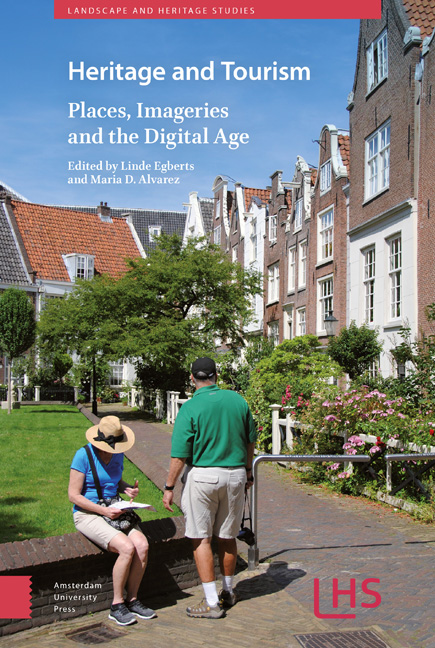Book contents
- Frontmatter
- Dedication
- Contents
- List of Figures and Tables
- Foreword
- 1 Tourism and Heritage: Crafting Experiences Through Innovation
- 2 Tourism Conflicts and Conflict Tourism: Curating “Holoscapes” in Europe’s Age of Crisis
- 3 Heritage Landscapes of Hiroshima and Nagasaki
- 4 Revealing and Presenting the Past(s) for the Public: Fethiye Mosque and Museum as a Cultural Heritage Site in Istanbul
- 5 Who Takes the Lead in Initiating Cooperation in a Cultural Network and Why?: The case study of a Rural Finnish Destination
- 6 Sustainability of Heritage-Tourism Destinations: A Demand-Based Perspective on Cusco, Peru
- 7 Localising National Tourism Websites: The case of World Heritage sites
- 8 Enhancing the Tourist Heritage Experience through “In-Situ”, Customisable, 3D-Printed Souvenirs
- 9 Tracking the Heritage Tourist: Heritage tourism and Visiting Patterns in a Historic City
- 10 The Construction of a Tourist-Historic Icon: The case of the Palace of Westminster, London
- 11 Conclusion
- Index
9 - Tracking the Heritage Tourist: Heritage tourism and Visiting Patterns in a Historic City
Published online by Cambridge University Press: 22 December 2020
- Frontmatter
- Dedication
- Contents
- List of Figures and Tables
- Foreword
- 1 Tourism and Heritage: Crafting Experiences Through Innovation
- 2 Tourism Conflicts and Conflict Tourism: Curating “Holoscapes” in Europe’s Age of Crisis
- 3 Heritage Landscapes of Hiroshima and Nagasaki
- 4 Revealing and Presenting the Past(s) for the Public: Fethiye Mosque and Museum as a Cultural Heritage Site in Istanbul
- 5 Who Takes the Lead in Initiating Cooperation in a Cultural Network and Why?: The case study of a Rural Finnish Destination
- 6 Sustainability of Heritage-Tourism Destinations: A Demand-Based Perspective on Cusco, Peru
- 7 Localising National Tourism Websites: The case of World Heritage sites
- 8 Enhancing the Tourist Heritage Experience through “In-Situ”, Customisable, 3D-Printed Souvenirs
- 9 Tracking the Heritage Tourist: Heritage tourism and Visiting Patterns in a Historic City
- 10 The Construction of a Tourist-Historic Icon: The case of the Palace of Westminster, London
- 11 Conclusion
- Index
Summary
Abstract
This article presents the results of an exploratory research project on the relation between tourists and the heritage presented in a historic city. Actual visiting patterns in a historic city are related to tourists’ motivational factors in order to better understand the role of heritage elements within a historic city. The sample is composed of heritage tourists arriving at the main train station in the city of Maastricht (Netherlands). Empirical testing involved the use of a structured questionnaire using face-to-face interviews. Besides, a GPS-tracker was used to identify the visiting patterns. Tourists’ motivational factors are classified in five groups and linked to the visiting patterns.
The results of the questionnaire showed various differences in terms of tourist characteristics, their level of interest in heritage and tourists’ motivational factors. The use of the GPS-tracker revealed some general visiting patterns regarding heritage in the historic inner city. It can be concluded that the attractiveness of this, so-called, tourist-historic city is at the expense of other heritage sites, especially those on the outskirts of the city. The relation between tourists’ motivational factors and visiting patterns appeared to be rather weak in this research and it was therefore not possible to draw meaningful conclusions about whether visiting patterns are grouped in a certain way that reflect the heritage tourists’ classification.
Though the results lead to a better understanding of reasons for visiting heritage places and provide further insight into heritage tourism in general. City planners and urban-tourism developers need this kind of information on motivations and behaviour of heritage tourists to target their plans for future development and marketing of heritage sites.
Keywords: heritage, tourism, visiting patterns, heritage tourism, historic city, city of Maastricht
Introduction
Heritage tourism is currently one of the most notable and widespread types of tourism in terms of visitors and attractions, appealing to hundreds of millions of people every year (Timothy, 2011). Heritage resources can be found in a wide variety of settings; one of the most common, however, is urban (Ashworth & Tunbridge, 2000). Historic buildings and environments are important elements of a city's ambience (Lazrak, Nijkamp, Rietveld, & Rouwendal, 2014) and lend it much of its appeal (Ashworth & Tunbridge, 1990). Besides that, monuments and other historic sites provide a popular background for a wide range of activities (Jansen-Verbeke & Lievois, 2008; Shoval & Raveh, 2004).
- Type
- Chapter
- Information
- Heritage and TourismPlaces, Imageries and the Digital Age, pp. 171 - 192Publisher: Amsterdam University PressPrint publication year: 2018



